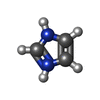+Search query
-Structure paper
| Title | The structure of the CS1 pilus of enterotoxigenic Escherichia coli reveals structural polymorphism. |
|---|---|
| Journal, issue, pages | J Bacteriol, Vol. 195, Issue 7, Page 1360-1370, Year 2013 |
| Publish date | Nov 21, 2012 |
 Authors Authors | Vitold E Galkin / Subramaniapillai Kolappan / Dixon Ng / ZuSheng Zong / Juliana Li / Xiong Yu / Edward H Egelman / Lisa Craig /  |
| PubMed Abstract | Enterotoxigenic Escherichia coli (ETEC) is a bacterial pathogen that causes diarrhea in children and travelers in developing countries. ETEC adheres to host epithelial cells in the small intestine ...Enterotoxigenic Escherichia coli (ETEC) is a bacterial pathogen that causes diarrhea in children and travelers in developing countries. ETEC adheres to host epithelial cells in the small intestine via a variety of different pili. The CS1 pilus is a prototype for a family of related pili, including the CFA/I pili, present on ETEC and other Gram-negative bacterial pathogens. These pili are assembled by an outer membrane usher protein that catalyzes subunit polymerization via donor strand complementation, in which the N terminus of each incoming pilin subunit fits into a hydrophobic groove in the terminal subunit, completing a β-sheet in the Ig fold. Here we determined a crystal structure of the CS1 major pilin subunit, CooA, to a 1.6-Å resolution. CooA is a globular protein with an Ig fold and is similar in structure to the CFA/I major pilin CfaB. We determined three distinct negative-stain electron microscopic reconstructions of the CS1 pilus and generated pseudoatomic-resolution pilus structures using the CooA crystal structure. CS1 pili adopt multiple structural states with differences in subunit orientations and packing. We propose that the structural perturbations are accommodated by flexibility in the N-terminal donor strand of CooA and by plasticity in interactions between exposed flexible loops on adjacent subunits. Our results suggest that CS1 and other pili of this class are extensible filaments that can be stretched in response to mechanical stress encountered during colonization. |
 External links External links |  J Bacteriol / J Bacteriol /  PubMed:23175654 / PubMed:23175654 /  PubMed Central PubMed Central |
| Methods | EM (helical sym.) / X-ray diffraction |
| Resolution | 1.6 - 20.0 Å |
| Structure data |  EMDB-1951:  EMDB-1952:  EMDB-1953:  PDB-4hji: |
| Chemicals |  ChemComp-IMD:  ChemComp-NA:  ChemComp-HOH: |
| Source |
|
 Keywords Keywords |  CELL ADHESION / CS1 pilus / COLONIZATION FACTOR / CELL ADHESION / CS1 pilus / COLONIZATION FACTOR /  pilin / chaperone-usher family / BACTERIAL SURFACE pilin / chaperone-usher family / BACTERIAL SURFACE |
 Movie
Movie Controller
Controller Structure viewers
Structure viewers About Yorodumi Papers
About Yorodumi Papers




